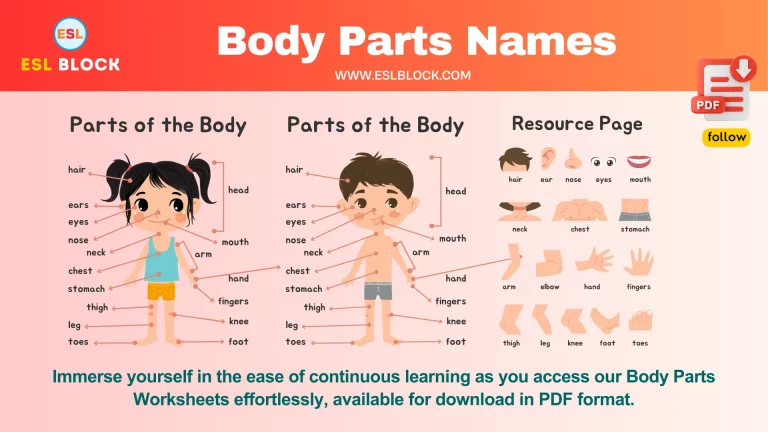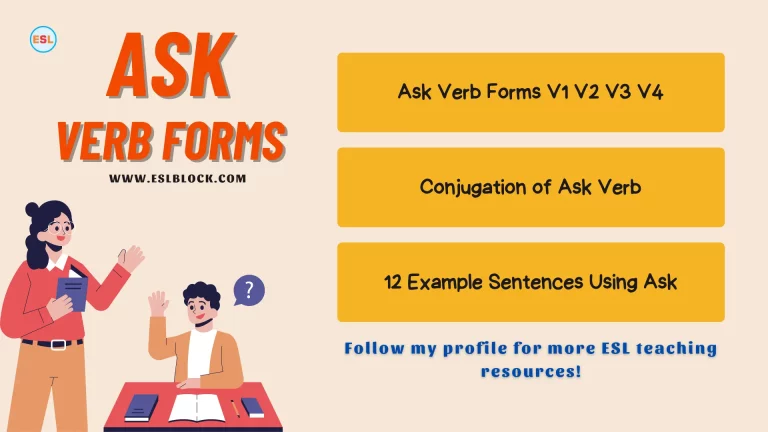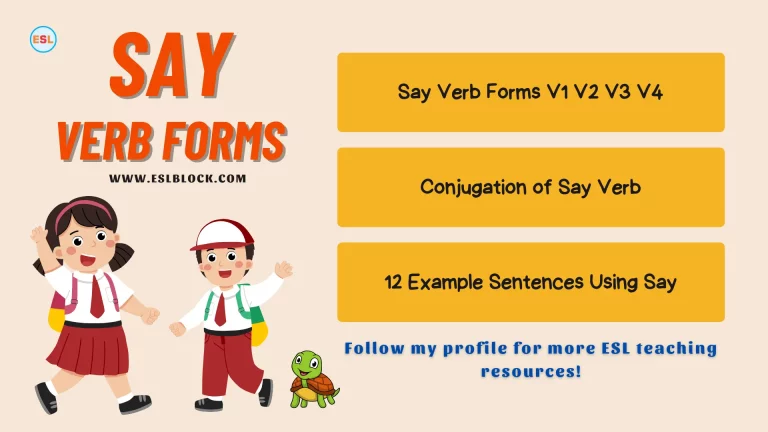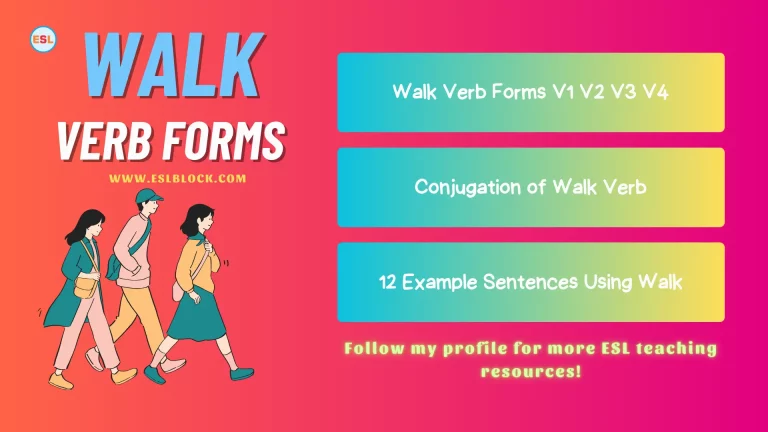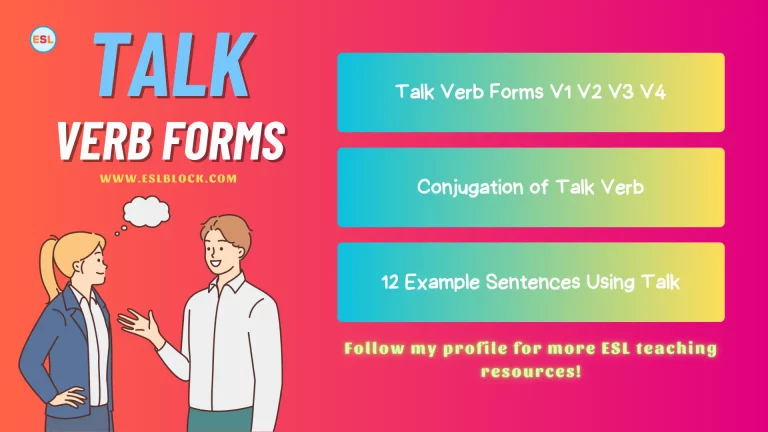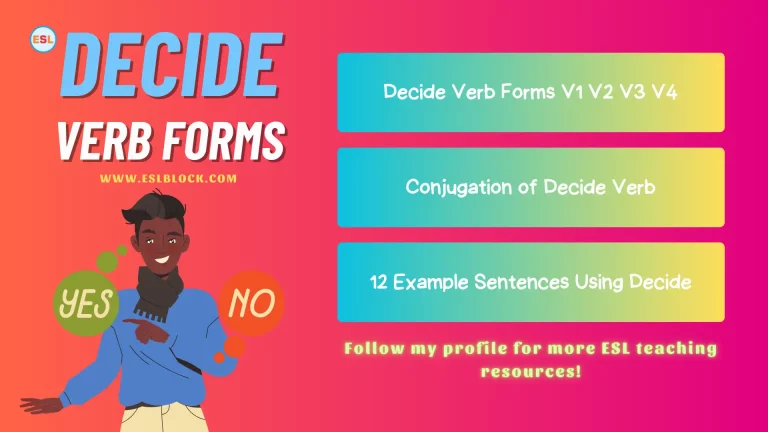What is a correlative conjunction, Examples, Rules, Exercise?
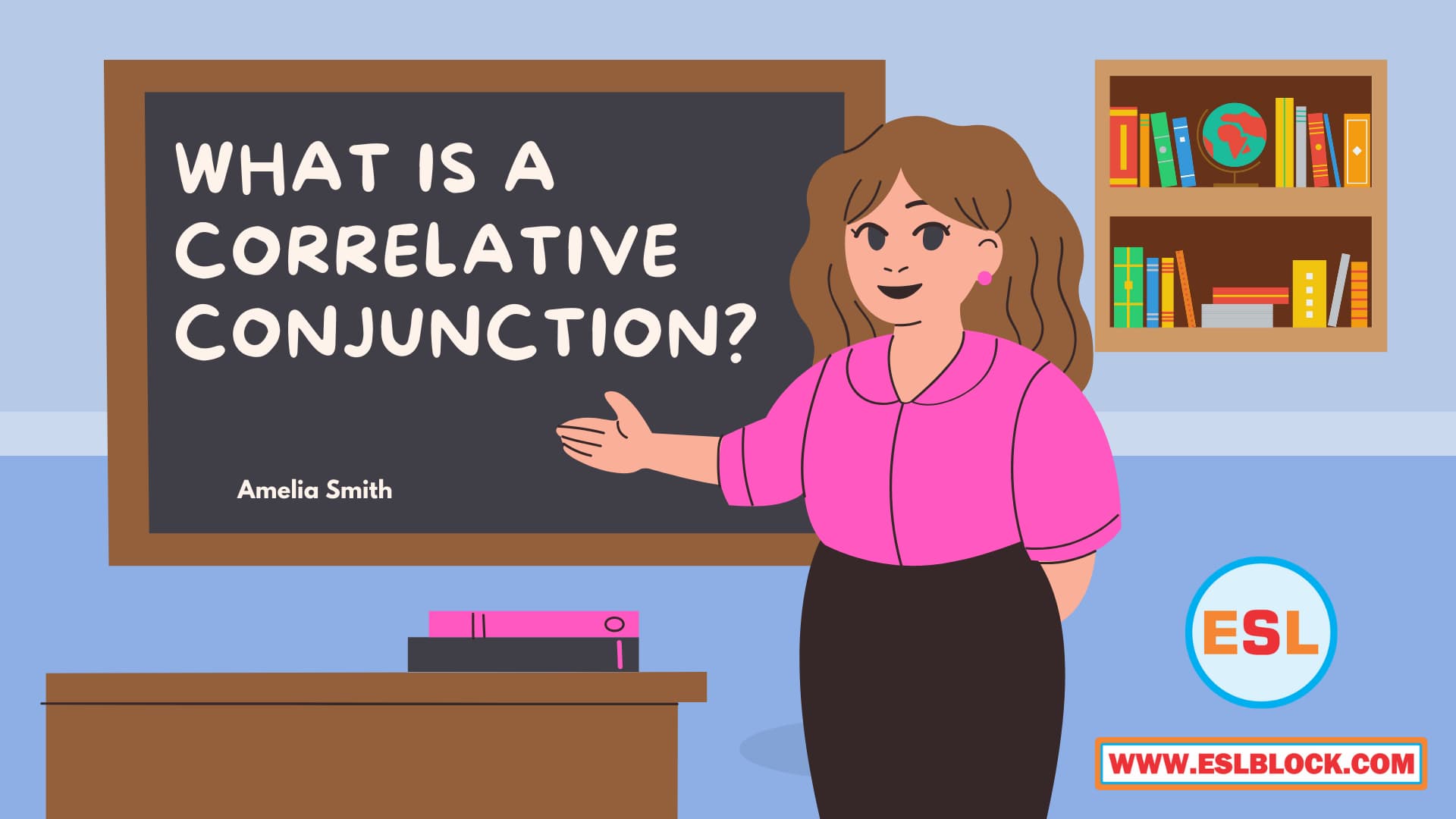
In this article, I am going to explain What is a correlative conjunction, Examples, Rules, and Exercise. Correlative conjunction is one of the three types of conjunctions. (The other two are subordinating conjunctions and coordinating conjunctions. Correlative conjunctions link words and phrases in sentences, which indicates the relationship between them. You may perform correlative conjunction quiz for more understanding.
Also read: What is a Conjunction in English Grammar?
What is a correlative conjunction?
Correlative conjunctions are the conjunctions that are used to show the way that two phrases or words within the same sentence are related to each other. They are usually used in pairs. You may test your understanding with our online Correlative Conjunction Quizzes!
Correlative conjunctions are used throughout your speech every day. You’ve likely used correlative conjunctions when you’ve said, “I do not like either the black ones or the green ones,” you’ve likely used correlative conjunctions. During writing, using correlative phrases can be beneficial to make the sentences more concise.
Look at these sentences that make use of correlative conjunctions:
- Neither my brother nor my sister live with my parents.
- I could play either high jump or pole vaulet next season.
- We could either swim in the lake or hike up the mountain this evening.
- Whether they bike or drive to office, they’ll need to show their parking pass.
Common Correlative Conjunction Pairs
Like gloves, correlative conjunctions ever come in pairs. That’s their defining feature; if conjunction doesn’t need a partner for its verdict to make sense, it’s not correlative conjunction. The most common correlative conjunction pairs include:
- as many/as
- both/and
- either/or
- neither/nor
- no sooner/than
- not only/but also
- rather/than
- such/that
- whether/or
Example Sentences of Correlative Conjunctions
Correlative conjunctive pairs work to show a relationship between two subject matter, give specifics, or give clarity. They are composed of the first conjunction linked to another section of the sentence by the second conjunction. A few standard correlative conjunctive terms are the following words.
The following examples have italicised/bold the correlative conjunctions for easy identification.
- Both/and: Using “both” and “and” indicates a correlation between two subjects performing the same activity. An example using these correlative conjunctions is: “They’ll both be leaving the hotel and taking one car.”
- Either/or: Using “either” and “or” connects two positive statements of equal weight. An example using these correlative conjunctions is: “My mother is either working upstairs or slacking off downstairs.”
- Neither/nor: “Neither/nor” connects two negative statements of equal weight. An example using these correlative conjunctions is: “Sophia will neither watch the movie nor read the novel.”
- Whether/or: “Whether/or” connects two possible actions. An example using this pair of correlative conjunction is: “I was not sure whether you would show up or not.”
- Not only/but also: “The dog is not only hungry but also thirsty.”
- Rather/than: “Rather/than” shows a subject’s preference for something over another. Using this correlative conjunction pair is: “We would rather have coffee than juice.”
- Such/that: “Such/that” connects two independent clauses in a way that applies a cause for action. An example using this pair of correlative conjunction is: “Such is the pain of my headache that I cannot get out of bed.”
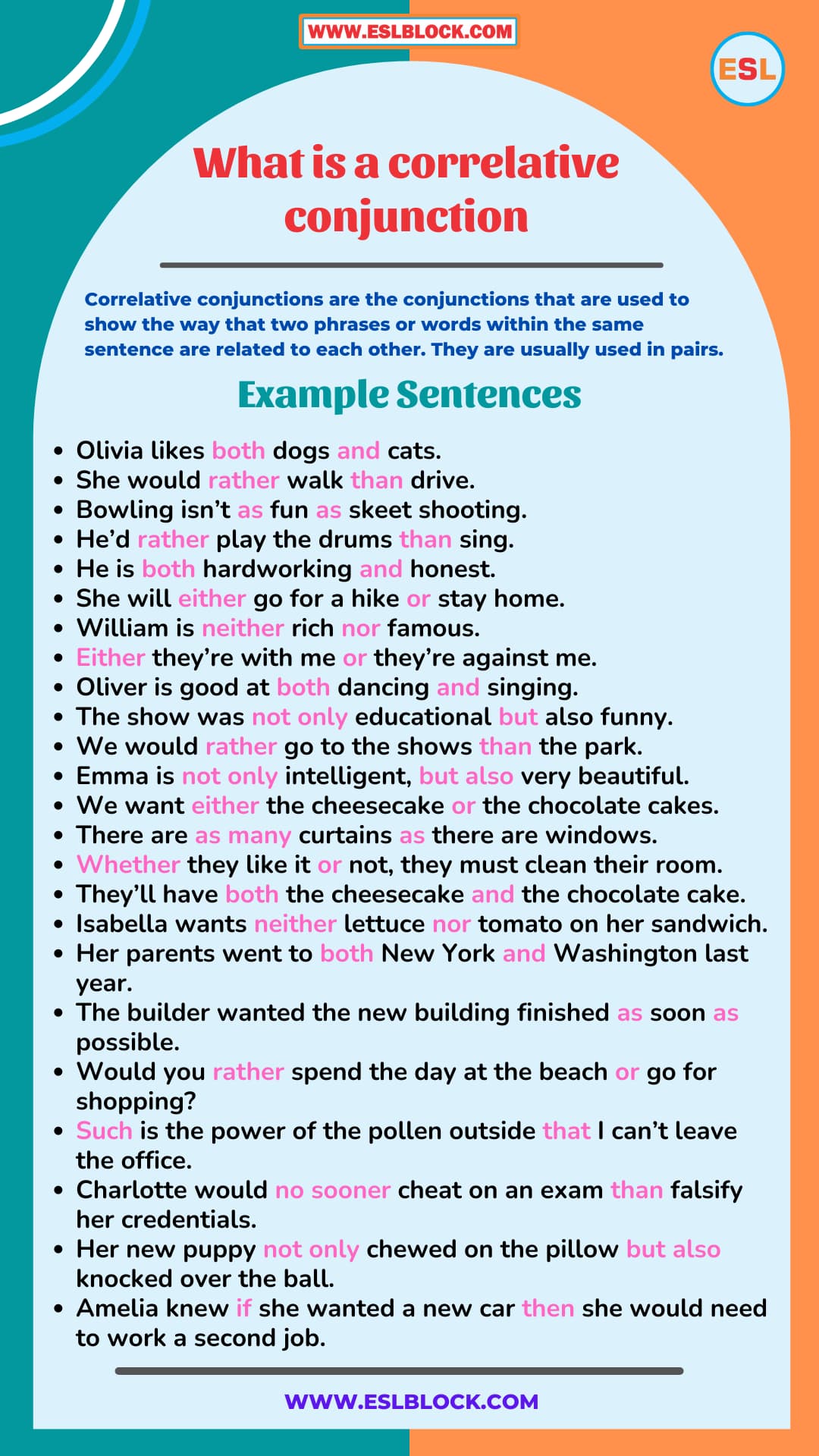
Some more Example Sentences of Correlative Conjunctions are:
- Olivia likes both dogs and cats.
- She would rather walk than drive.
- Bowling isn’t as fun as skeet shooting.
- He’d rather play the drums than sing.
- He is both hardworking and honest.
- She will either go for a hike or stay home.
- William is neither rich nor famous.
- Either they’re with me or they’re against me.
- Oliver is good at both dancing and singing.
- The show was not only educational but also funny.
- We would rather go to the shows than the park.
- Emma is not only intelligent, but also very beautiful.
- We want either the cheesecake or the chocolate cakes.
- There are as many curtains as there are windows.
- Whether they like it or not, they must clean their room.
- They’ll have both the cheesecake and the chocolate cake.
- Isabella wants neither lettuce nor tomato on her sandwich.
- Her parents went to both New York and Washington last year.
- The builder wanted the new building finished as soon as possible.
- Would you rather spend the day at the beach or go for shopping?
- Such is the power of the pollen outside that I can’t leave the office.
- Charlotte would no sooner cheat on an exam than falsify her credentials.
- Her new puppy not only chewed on the pillow but also knocked over the ball.
- Amelia knew if she wanted a new car then she would need to work a second job.
What does a correlative conjunction do?
Correlative conjunctions form combinations of elements similar to each other. By “elements,” we mean phrases and words within the sentence that are identical to each other or perform the same function. It could refer to two adjectives, two nouns, two verbs, or two words of the same type of phrase. Here are some examples of correlative conjunctions in sentences:
- Because of the bad weather, Amelia missed both her chemistry and physics exams.
- Benjamin not only ate all the cakes but also drank all the milk.
- He wasn’t sure whether the play was disjointed or avant-garde.
When should you use correlative conjunctions?
Use correlative conjunctions when you can use two distinct but related concepts in a sentence. If you and your friend tend to get up early, an excellent sentence to convey that can be ” Both my roommate and I wake up early.”
How to use correlative conjunctions?
Correlative conjunctions always are in pairs. Many of them are used in place of their correlative counterparts, in which case if it happens, it isn’t functioning as correlative conjunction. Here’s an example of this:
- Sophia was such an amazing teacher.
In this sentence, the word “such” is an adverb because it’s modifying the adjective. But the word “such” can also be a correlative conjunction—when it is paired with the word “that.”
- Sophia was such an amazing teacher that she won over even the best teacher award.
Rules for Using Correlative Conjunctions
There are many valuable tips and guidelines for using these parts of speech in the sentence. Here are some Rules for Using Correlative Conjunctions.
1. Mind your subject-verb agreement
Verbs and subjects must coincide in conjunctions that use correlative. Single subjects should match singular verbs, and plural subjects must be matched to plural verbs. If you have more than one subject, match the verb to the one most closely related to it. For example, you could write: “Both the owner and his dogs run through the park,” instead of “Both the owner and his dogs runs through the park.”
2. Ensure your pronoun agreement
Like subject-verb agreement, pronouns also need to agree with their verbs when using correlative conjunctions. For instance, “She plays tennis” is the correct agreement between a pronoun and a verb, not “She plays tennis.” This could be unclear when the pronoun’s antecedent forms in a related pair. Choose the one closest to the noun or phrase if there are multiple subjects. Take the phrase, “Not just my sister but my friends were all there.” In this example, “were” matches the number of “friends” rather than matching it with”sister. “sister.”
3. Make sure your sentence has a parallel structure
Parallelism is an essential grammar to track the main subjects of your paragraphs. Parallel structure is concerned with the grammatical format for your phrases, such as discussing multiple items or making lists. For instance, let’s take a look at the pair of sentences below “My mom likes to hike, but also is a fan of camping” and “My mom likes hiking but also camping.” In the second statement, “hiking” and “camping” are in a parallel fashion, but “to hike” and “camping” are not in parallel with one another in the first sentence.
4. Use a comma with independent clauses
Use the punctuation mark when the correlative conjunction separates two distinct clauses. Also, please do not use it to distinguish the different correlative terms. Let’s look at two sentences below “Neither you nor I should wear pastels” and “Neither you nor I should wear pastels.” In this instance, the former is correct since both subjects are dependent on the same verb that can be described as “wear.”
5. Watch out for double negatives
There is no negative connotation in either of them; therefore, ensure your main clause doesn’t include a negative verb phrase. “I can’t neither see it nor hear it” isn’t correct since “can’t” already provides a negative connotation. The correct translation is: “I can neither see nor hear it.”

Correlative Conjunctions Exercises
These exercises will help you understand how Correlative conjunctions work. To complete each sentence, choose the best answer.
- Scarlett is neither honest _______ funny.
- _______ that is the problem, _______ I’m not surprised.
- Have they made a decision about _______ to go to the bars _______ not?
- _______ had I put my umbrella away, _______ it started raining.
- This banana is _______ healthy _______ delicious.
- She likes __________ to sing opera, __________ to spend my spare time practicing dance.
- The exam was __________ quite easy __________ very short.
- ________ Jackson _______ his sisters could understand what their parents were saying when they spoke German.
Answer Key:
- Scarlett is neither honest nor funny.
- If that is the problem, then I’m not surprised.
- Have they made a decision about whether to go to the bars or not?
- No sooner had I put my umbrella away, than it started raining.
- This banana is both healthy and delicious.
- She likes not only to sing opera, but to spend my spare time practicing dance.
- The exam was both quite easy and very short.
- Neither Jackson nor his sisters could understand what their parents were saying when they spoke German.
What is a correlative conjunction InfoGraphics
Here are some printable infographics about what is a correlative conjunction? Printable infographics are a fantastic way to share a significant amount of details in a short time in a stunning way. The correlative conjunction with Examples infographic can help teachers and students to share their thoughts easily.
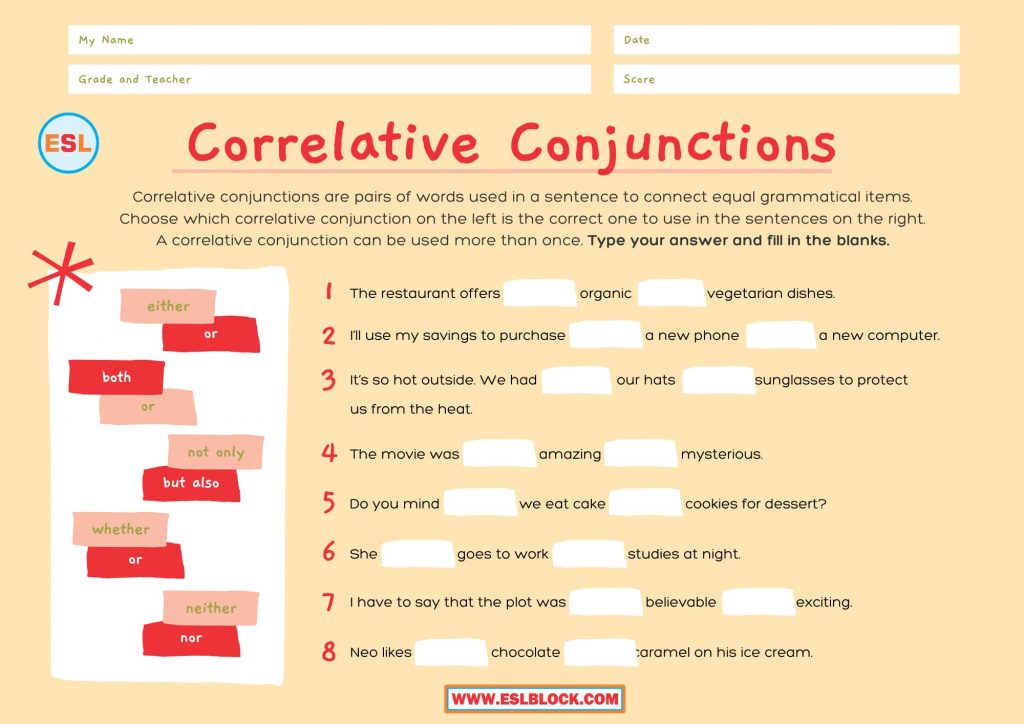
My Considerations
With this set of rules of using correlative conjunctions with Examples, you will quickly determine whether you are making the most effective use of the correlative conjunction and how they could be used to enhance English writing skills.
Since the correlative conjunctions are the main part of English Grammar, the importance of developing English learning skills cannot be undervalued without Rules of Using correlative conjunctions with Examples.
You can read the above sample sentences about what is a correlative conjunction to improve your understanding of English grammar.
Encourage your children to learn these basic but commonly used correlative conjunction with Examples, by following the simple example sentences given above. Then, save this list of correlative Conjunction Example Sentences, handy for your kids in the future.
If you enjoyed a printable infographic about what is a correlative conjunction, I’d be very thankful if you’d help it spread by emailing it to your friends or sharing it on Pinterest, Reddit, Twitter, Instagram, or Facebook. Thank you!
Also read: Adjectives That Start With Y
Recap of what we just learned
- What is a correlative conjunction, Examples, Rules, Exercise?
- What is a correlative conjunction?
- Correlative Conjunction Rules
- Mind your subject-verb agreement
- Ensure your pronoun agreement
- Make sure your sentence has a parallel structure
- Use a comma with independent clauses
- Watch out for double negatives
- Examples of correlative Conjunctions
- Correlative Conjunctions List
- Correlative Conjunctions Exercises
- Correlative Conjunctions Exercises
- What is a correlative conjunction InfoGraphics
With ESLBLOCK, you will not face problems studying new ideas. If you are in doubt, about the qualities of blog posts about what is a correlative conjunction, reach us through our blog’s comment section. Keep checking back! We’ll attempt to give you feedback as early as possible. Thank you!
Also read: Adjectives That Start With Z
Correlative Conjunction Quizzes
Related Topics
Explore the full list of Adjectives to Describe a Person from A to Z!
- A Adjectives to Describe a Person
- B Adjectives to Describe a Person
- C Adjectives to Describe a Person
- D Adjectives to Describe a Person
- E Adjectives to Describe a Person
- F Adjectives to Describe a Person
- G Adjectives to Describe a Person
- H Adjectives to Describe a Person
- I Adjectives to Describe a Person
- J Adjectives to Describe a Person
- K Adjectives to Describe a Person
- L Adjectives to Describe a Person
- M Adjectives to Describe a Person
- N Adjectives to Describe a Person
- O Adjectives to Describe a Person
- P Adjectives to Describe a Person
- Q Adjectives to Describe a Person
- R Adjectives to Describe a Person
- S Adjectives to Describe a Person
- T Adjectives to Describe a Person
- U Adjectives to Describe a Person
- V Adjectives to Describe a Person
- W Adjectives to Describe a Person
- X Adjectives to Describe a Person
- Y Adjectives to Describe a Person
- Z Adjectives to Describe a Person


